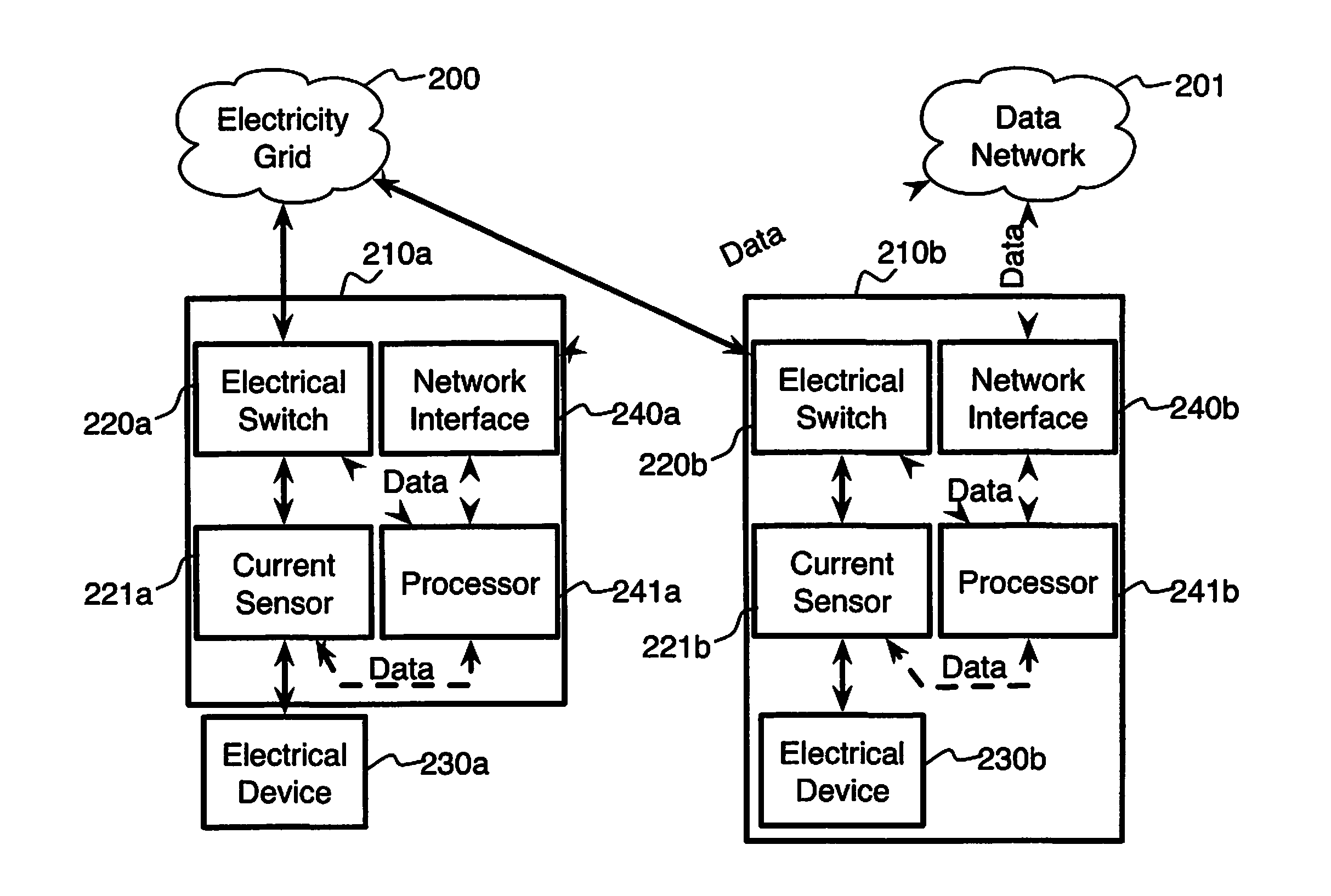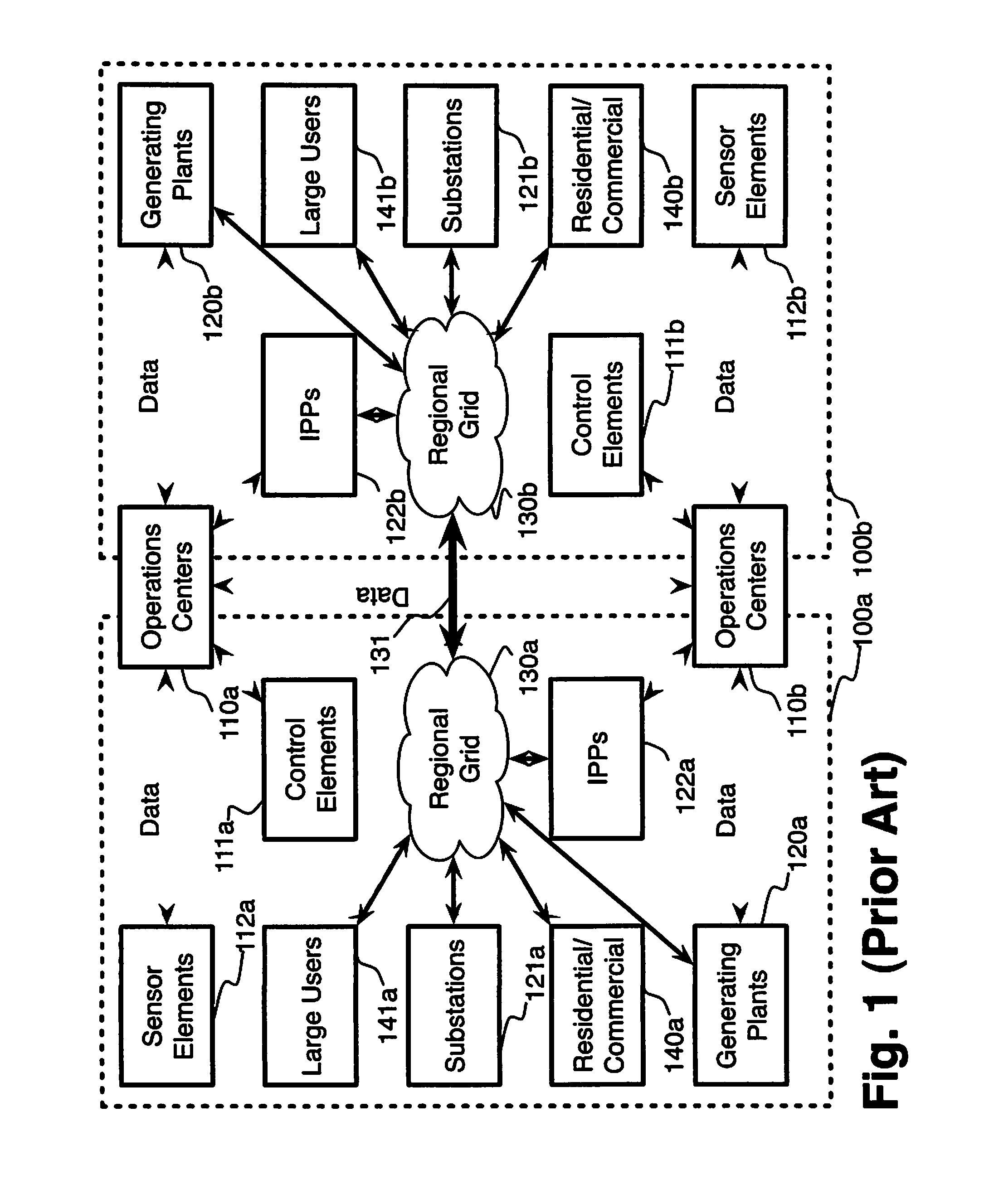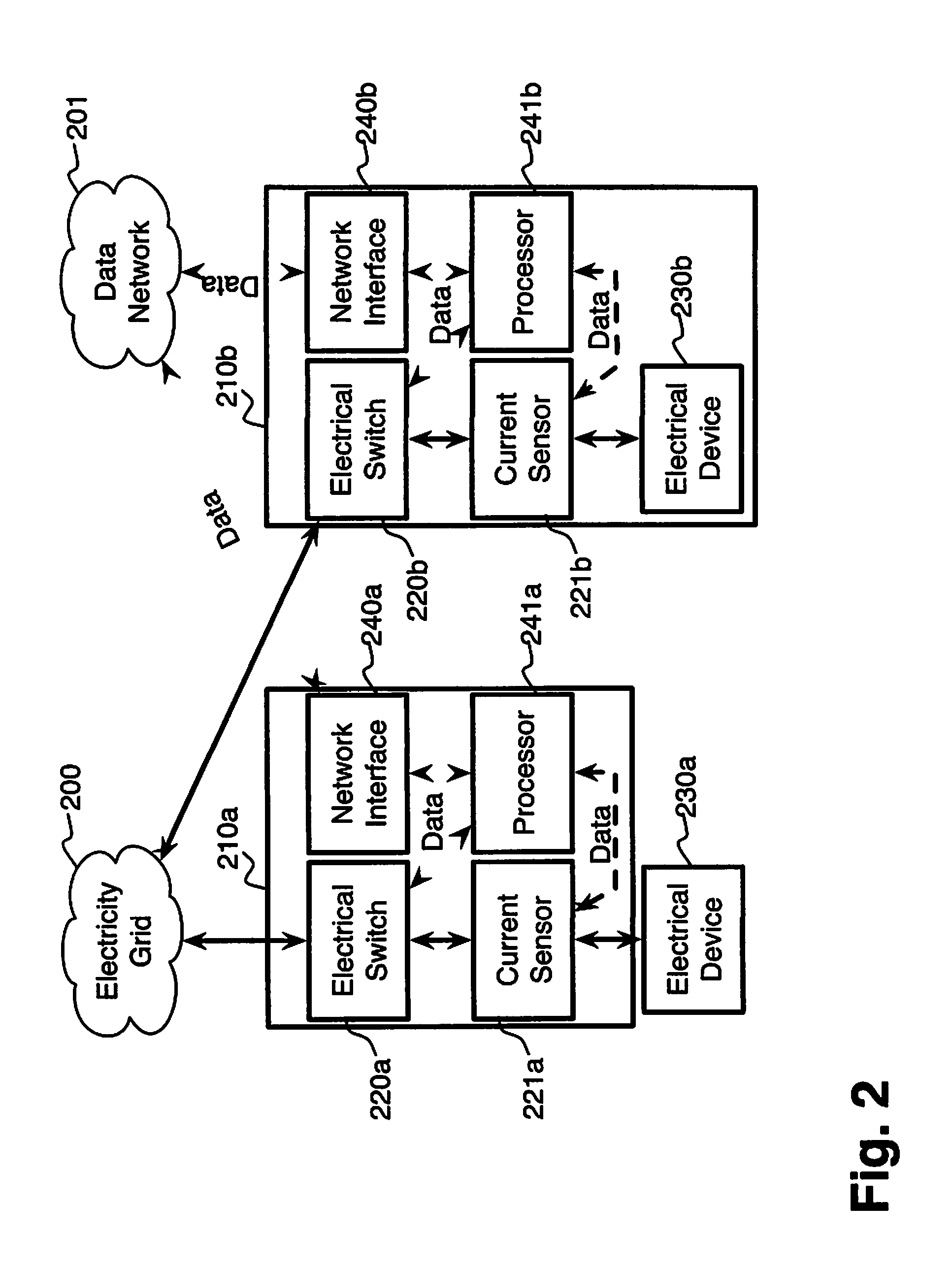While a robust
electric power grid is widely recognized as a vital infrastructure component of a developed economy, technological progress in the field of
electricity grid systems has not kept up with the pace of other important technological fields such as
telecommunications.
Additionally, the current regulatory scheme in the United States discourages large-scale investment in transmission and distribution infrastructure, with the unfortunate result that the grid is often running near capacity.
A number of techniques have been devised to assist in maintaining grid stability during times of
high stress, which normally means peak usage hours but also includes periods during normal usage when part of the grid goes offline, thus reducing the
effective capacity of the grid or a region of it.
A problem with the current state of the art in demand reduction is that it is only practical, in the art, to incorporate very large users in demand reduction programs.
Unfortunately, a large portion (roughly 33%) of the
electric power used during peak periods goes to small users, who do not normally participate in demand management.
These users often are unaware of their energy usage habits, and they rarely pay for
electricity at varying rates.
Partly this is due to the fact that the large majority of small businesses and homes do not have “smart meters”; the amount of power used by these consumers of electricity is measured only once per month and thus there is no way to charge an interval price (typically pricing is set at intervals of 15 minutes when interval pricing is in effect) that varies based on
market conditions.
Furthermore, the loads in the homes and businesses of small electricity users are invisible to the utilities; it is generally not possible for utilities to “see”, much less to control, loads in homes and small businesses.
It is a
disadvantage of the techniques known in the art that the consumers and small businesses are not, in general, provided with any substantial financial incentives to participate in demand reduction programs (other than merely by saving because they use less power).
This method similarly discourages
consumer participation, because the majority of the financial rewards associated with the
demand response are not generally passed along to the
consumer.
The companies that aggregate demand typically charge utilities for the peak reduction, but the
consumer is unable to sell their available “negawatts” directly to a utility.
This is problematic because this methodology reduces consumer incentives to participate in
demand side management, which is a necessary component of modern
grid management.
And adoption is hampered by the general lack of willingness on the part of consumers to allow utilities to control significant portions of their electricity usage with the consumer having little “say” in the matter.
And, from the utilities' point of view, the large variations in consumer usage patterns means that it is much harder for utilities to gage how much demand reduction is enough, in advance; compared to large, stable users such as large office buildings or industrial facilities, utilities face a complex mix of user patterns that are difficult to predict and virtually impossible to control.
Another problem in the art today is the incorporation of
distributed generation and storage systems, which are proliferating, into grid demand management systems.
In many cases, consumers are unable to do more than to offset their own electric bills with generation units (such as microturbines powered by wind, or solar panels on a roof, or plug-in electric
hybrid vehicles that could add energy to the grid when needed), because utilities have neither the means nor the motivation to pay them for the extra electricity they generate.
Many states require utilities to buy excess power generated; but, without an ability to sell that generated power at a price that represents a more holistic view of its value that includes “embedded benefits” (i.e. at a rate that may consider, but is not limited to, the effect on enhancing local
power quality, proximity to loads, type of power generated and the associated reduction in carbon and other negative externalities—like
sulfur dioxide and
nitrogen dioxide—and the reduced capital costs resulting from the reduction of required capital investments in infrastructure), most
distributed power generation remains economically unfeasible, to the detriment of all parties.
Additionally, while storage units may allow users to avoid peak charges and to even the flow of locally generated power (for instance, by storing
wind power during high wind conditions and returning it when the wind conditions are low), it is generally not possible for users to sell stored power to the
grid operator at its true value for the same reasons.
An additional challenge associated with integrating distribute
energy resources with the grid is the lack of a cost-effective means of aggregating
distributed power generation into a form that can be traded in a manner similar to the large blocks of power that are bought and sold by more traditional commercial power plants like
coal and nuclear.
Complex industry rules discourage participation and even consolidators have been hesitant to enter the market given the high set up costs associated with communications,
staffing, and industry monitoring.
An underlying difficulty that contributes to the problems already described is that consumers (commercial, industrial, institutional, or residential participants in energy markets) have no way to differentiate between one unit of energy and another in
energy distribution systems, such as the electric grid, that are best viewed as “continuous-flow energy networks”.
That is, a consumer cannot differentiate one kilowatt of electricity arriving at her home or business from another, and in general has no ability to differentiate between energy having desirable qualities (to her) such as renewability, low
carbon footprint, derivation from local or at least domestic (as opposed to foreign) sources, and so forth.
While in some cases utilities make available about information about the aggregate sources of their electricity, and while they may in some cases make a small number of “packages” available to consumers based on differing mixes of sources (for instance, “black, green and in between” menu choices based on percentage of renewable or low-carbon sources for each option, with prices varying accordingly), it is in general true that consumers have no information about the particular energy they are using at any given time, and no ability to make informed choices as energy consumers.
There are two main problems with the older meter
system: first, meter readers are expensive; second, because readings can only practically be taken at long intervals, there is no way for utilities to measure usage specifically during particular time intervals such as a peak hour.
Without the ability to make readings at frequent intervals (a common desired target is to have fifteen-minute readings), it is practically impossible for utilities to offer or impose demand-based pricing schemes, for instance where electricity prices are set higher during periods of
peak demand.
But the cost of deploying smart meters is quite high, typically reaching several hundred dollars per installed
smart meter.
With tens of millions of ratepayers in the United States alone, switching completely to smart meters will likely cost many billions of dollars, and it will take a considerable period of time.
Besides their high costs, smart meters suffer from another
disadvantage, albeit one which would not trouble utilities themselves.
Since smart meters are being deployed exclusively by utilities in the United States (since it has always been the responsibility of the utilities to install, maintain, and own usage meters), widespread deployment of smart meters will tend to lock in consumers with their local utility.
If real-time markets are not developed in parallel with
smart meter deployments,
smart meter deployment will reinforce utilities' stranglehold on their consumer base, which may not serve the best interests of consumers or the economy as a whole.
These include familiar risks such as the creditworthiness of counterparties in energy transactions, but these familiar risks are taken into unfamiliar territory when large numbers of less sophisticated market participants are considered (such as where small businesses and residences participate in
demand response management programs or contribute power to the grid for distributed energy sources).
Other types of potentially relevant risks are new, including such novel risks as the risk that, when large numbers of small participants elect to respond to a
demand response management
signal, their
geographic distribution creates stability problems on the grid.
This is a distinct challenge compared to the purely financial risks that are commonly measured and allocated in financial derivatives.
In addition to the practical challenges associated with integration of large quantities of
renewable energy resources and distributed
energy resources (generation and storage), the energy markets must have tools to effectively price the effect of infrastructure reliability on the network due to the
physical limitations of the network to deliver electricity to end-users.
In addition to challenges in management of the grid, the existing
energy market structure results in inefficient pricing and taxation of market externalities.
The inability to effectively attribute
system losses (e.g. transmission losses) to network / market participants stems from the current inability to facilitate
nodal allocation of energy on
continuous flow energy networks (that is, allocation of real costs and externalities associated with energy transformations on a node-by-node basis, for instance by assigning a carbon cost to electricity losses on a high-
voltage transmission line and then allocating that cost to each user of electricity which was transmitted along that
transmission line).
But in commodities futures, the actual delivery of commodities on settlement of a contract is not facilitated or managed by the market or exchange that handled transactions involving the futures contract; what is traded on such exchanges are contractual obligations only.
In situations where exchanges may actually involve themselves in the delivery of the underlying physical assets being traded, and may take on a certain measure of risk with regard to such deliveries, the pricing of futures contracts becomes more complicated as there may be at least three parties bearing some measure of risk associated with each contract: a buyer, a seller, and an exchange.
This is due to lack of
visibility to most players regarding line losses (which are often as much as 8-10% of electricity generated) and
system requirements such as ancillary services, both of which remain unattributed to end-users.
For example,
voltage support required for a large factory is not attributed to the factory in any meaningful way, leading to a free-rider problem.
Loop flow becomes a problem when bilateral transactions between market participants extend to cause flow problems in third-party systems (i.e. other parts of the network).
More generically, this problem is a direct result of the inability to directly control the flows between any two points on the network within the
grid network without influencing line flows elsewhere on the system.
This assumption of uniform
power quality and instantaneous balancing of energy assets on the network is not necessarily useful.
Control Area concepts are not required for efficient and reliable provision of services and management of the electric grid.
In fact, the assumption that all users require the same
power quality and consistency of access is in some cases detrimental to parts of society who may be unable to pay for such services or end up paying for such services without understanding the true sources of the associated costs.
The
control area concept and many of the centralized dispatch and scheduling mechanisms utilized today introduce large inefficiencies into the system and provide problems for the provision of effective low cost energy services due to scheduling and dispatch limitations associated with fixed scheduling mechanisms.
Another challenge of energy is that the end consumer requires energy to run their home or business.
Users lack an ability to optimize their total comfort based on economic variables.
 Login to View More
Login to View More  Login to View More
Login to View More 


